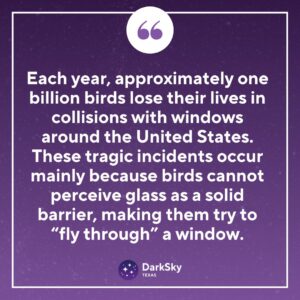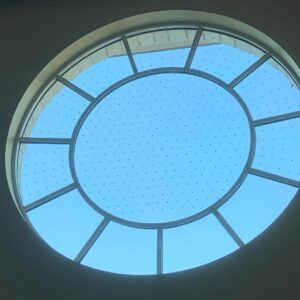Between July and November, the skies of Texas fill with the graceful silhouettes of migrating birds. It is particularly magical to hear or see hundreds of thousands of birds flying overhead. Over the months of each migration season, approximately two billion birds will travel across Texas.
At DarkSky Texas, our primary mission is to combat light pollution. And yet, since we already feel deeply invested in preserving Texan ecosystems, we want to shed extra light on the effects of human-built environments on migrating birds – and more importantly, on how seemingly small décor decisions can protect our feathered friends!
Why Bird-Friendly Windows Matter

Each year, estimates suggest millions of birds die in collisions with windows in Texas alone. These tragic incidents occur mainly because birds cannot perceive glass as a solid barrier, or they see vegetation reflected in them making them try to “fly through” a window.
What’s curious is that many of these collisions involve regular one or two-story homes rather than tall skyscrapers – despite many of these homes being much lower than the usual “bird height.” Clearly, something is sending these birds down an unusual path! (Hint: it may be our outdoor lights).
The impact of these collisions extends far beyond individual birds. Many migratory species play crucial roles in their ecosystems, acting as pollinators, seed dispersers, and natural pest controllers. The loss of these birds can have ripple effects throughout the food web, affecting plant populations and even human agriculture.
Lights and Bird-Friendly Windows: 3 Adjustments You Can Make
As part of our ongoing drive to combat light pollution, we have embarked on a massive educational campaign for “responsible outdoor lighting.” As it turns out, many of the adjustments that curb light pollution can also make our windows safer for birds.
Keep in mind that birds start migrating each evening around dusk. So, the lights you have on early in the evening can be just as dangerous as those during the heaviest part of migration in the middle of the night.
Here are three simple tactics to make your lighting bird-friendly:
- Turn off non-essential outdoor lighting: Turn off decorative lights and lights that are on when no one is there to use them.
- Reduce intensity: Use lower-wattage, warmer colored bulbs or dimmer switches to decrease the overall brightness of your outdoor lighting. This can help prevent birds from becoming attracted to or disoriented by your property.
- Use shields to target the light: Install light fixtures with shields that direct light downward and prevent it from spilling into the sky or reflecting off windows. This can significantly reduce the likelihood of bird collisions.
What About the Glass?

While adjusting lighting is crucial, addressing the glass itself is equally important – after all, this is the “direct culprit” behind most bird collisions. Here are some effective ways to make your windows more visible to birds:
- Create patterns on your glass panels: Apply stripes or dots to the outside of the glass using commercially prepared systems or tempera paint. The key is to create a pattern that breaks up reflections and makes the glass visible to birds. See the link in #4 for spacing.
- Use opaque or frosted glass: For new construction or replacements, consider using glass that’s inherently more visible to birds, such as frosted, etched, or opaque glass.
- Add blinds or curtains behind the glass: Keep blinds and curtains partially closed to break up reflections and make the glass more visible. As a bonus, this will also prevent indoor lights from “trespassing” into outdoor areas.
- See our partner Audubon’s recommendations for bird-friendly window options and their spacing.
- Get solar protection and bird safety in one package: Consider this new product recommended by the American Bird Conservancy.
Final Thoughts
As we marvel at the wonder of bird migration this season, let’s remember that our choices at home and our office can significantly impact the success of these incredible journeys. By making our windows bird-friendly and being mindful of our lighting, we’re not just saving individual birds – we’re contributing to the health of our entire ecosystem.
Check out Birdcast, from the Cornell Lab of Ornithology. It provides live migration forecasts. You can view the predicted bird migration traffic in your area and sign up for alerts.
At DarkSky Texas, we have long advocated for reducing light pollution to see better, protect nocturnal wildlife, and preserve our view of the stars. We invite you to join us in this effort. Whether by implementing the suggestions in this article, by earning the BE A STAR Award, or by supporting our organization through a donation, your actions can make a real difference in protecting our feathered friends.
Image Credit: Photo by Alexandr Hovhannisyan on Unsplash


